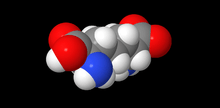Diaminopimelic acid
 | |
 | |
| Names | |
|---|---|
| IUPAC name
(2R,6S)-2,6-Diaminoheptanedioic acid | |
| Identifiers | |
| 583-93-7 | |
| ChEBI | CHEBI:16488 |
| ChEMBL | ChEMBL415306 |
| ChemSpider | 89700 |
| 5021 | |
| Jmol interactive 3D | Image |
| MeSH | Diaminopimelic+acid |
| PubChem | 1549101 |
| |
| |
| Properties | |
| C7H14N2O4 | |
| Molar mass | 190.20 g/mol |
| Appearance | white powder |
| Density | 1.344 g/mL |
| Melting point | 295 °C (563 °F; 568 K) |
| Boiling point | 426.7 °C (800.1 °F; 699.8 K) |
| Hazards | |
| Main hazards | Irritant |
| Except where otherwise noted, data are given for materials in their standard state (at 25 °C [77 °F], 100 kPa). | |
| | |
| Infobox references | |
Diaminopimelic acid (DAP) is an amino acid, representing an epsilon-carboxy derivative of lysine.
DAP is a characteristic of certain cell walls[1] of some bacteria. DAP is often found in the peptide linkages of NAM-NAG chains that make up the cell wall of gram-negative bacteria. When provided, they exhibit normal growth. When in deficiency, they still grow but with the inability to make new cell wall proteoglycan.
This is also the attachment point for Braun's lipoprotein.[2]
See also
Images

An alternate view of the DAP structure.
References
| ||||||||||||||||||||||||||||||||||||
This article is issued from Wikipedia - version of the Sunday, November 01, 2015. The text is available under the Creative Commons Attribution/Share Alike but additional terms may apply for the media files.